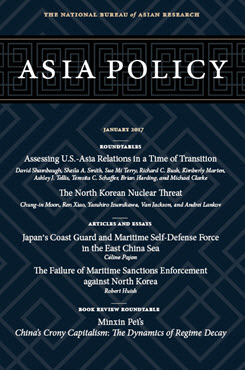The North Korean Nuclear Threat
Regional Perspectives on a Nuclear-Free Peninsula
The United States and East Asian states have tried various methods to compel North Korea to abandon its nuclear weapons program, but no successful formula has emerged. This Asia Policy roundtable contains five essays that examine the relationships between North Korea and China, Japan, South Korea, and the United States and assess the prospects for denuclearization.
Introduction
Managing North Korean Nuclear Threats: In Defense of Dialogue and Negotiations
Chung-in Moon
Old Wine in a New Bottle? China’s Korea Problem
Ren Xiao
Acting on the North Korea Playbook: Japan’s Responses to North Korea’s Provocations
Yasuhiro Izumikawa
Deterring a Nuclear-Armed Adversary in a Contested Regional Order: The “Trilemma” of U.S.–North Korea Relations
Van Jackson
Why Nothing Can Really Be Done about North Korea’s Nuclear Program
Andrei Lankov
Introduction
In 2016, North Korea successfully completed its fourth and fifth nuclear weapon tests and redoubled its efforts to develop a credible delivery system. The Kim Jong-un regime thus appears committed to continuing the byungjin (parallel development) policy that has made the pursuit of nuclear weapons a cornerstone of North Korea’s national security strategy. Most analysts believe that the country currently possesses 10–16 nuclear weapons and, under low to moderate growth estimates, could develop 20–50 weapons by 2020. Statements by Kim in early 2017 indicate a persistent drive to couple these weapons with fully operational ballistic missile systems that can directly threaten the U.S. mainland in addition to U.S. allies in Asia.
Over the last two decades, the United States, its East Asian allies, and other regional stakeholders have tried varying degrees of diplomacy, threats, and sanctions to compel Pyongyang to abandon its nuclear program, but to date no successful formula has emerged. The Obama administration’s policy of “strategic patience” with North Korea produced little change to the status quo, and the regime’s growing nuclear proficiency is rapidly becoming a problem that its neighbors in Northeast Asia can no longer ignore. Each state, however, has different perspectives on how to best respond and implement strategies that will bring about change on the Korean Peninsula.
This Asia Policy roundtable contains five essays that examine the relationships between North Korea and South Korea, China, Japan, and the United States. First, Chung-in Moon outlines South Korea’s recent approach toward Pyongyang and argues that the time may be right for a return to diplomacy. Ren Xiao explains China’s current challenge of balancing growing fears of North Korea’s nuclear capabilities with wariness over the insecurity that might arise on China’s borders if strong international intervention brings about the collapse of the Kim regime. Yasuhiro Izumikawa discusses Japan’s current strategy of enhanced sanctions, reliance on U.S. nuclear deterrence, and security cooperation with South Korea and examines the durability of this playbook. Van Jackson argues that the United States faces a “trilemma” with North Korea as a deterrence challenge, a proliferation concern, and a wildcard to the regional order. He concludes that competing strategies to solve these issues will require Washington to take proactive and risky approaches to achieving a resolution. Finally, Andrei Lankov analyzes North Korea itself and asserts that a steadfast commitment to regime survival and a “hyperrealist” view of international relations will continue to motivate Pyongyang’s uncompromising approach to security.
South Korea, China, Japan, and the United States all bring a different strategic calculus to the problem of North Korea’s nuclear program. The essays collected in this roundtable, however, demonstrate that each approach—from diplomatic engagement to more robust sanctions and threats of force—has so far failed to produce substantive change in North Korea. Given the Kim regime’s persistent agenda and incendiary rhetoric, the roundtable authors all agree that robust engagement between the United States and the other stakeholders and clearer communication—whether through deterrence or diplomacy—with North Korea itself will be needed. Such cooperation might at times require that states prioritize policies that perhaps sacrifice some strategic interests to achieve the common objective of a North Korea free of nuclear weapons.
About Asia Policy
Asia Policy is a peer-reviewed scholarly journal presenting policy-relevant academic research on the Asia-Pacific that draws clear and concise conclusions useful to today’s policymakers. Asia Policy is published quarterly in January, April, July, and October and accepts submissions on a rolling basis. Learn more


